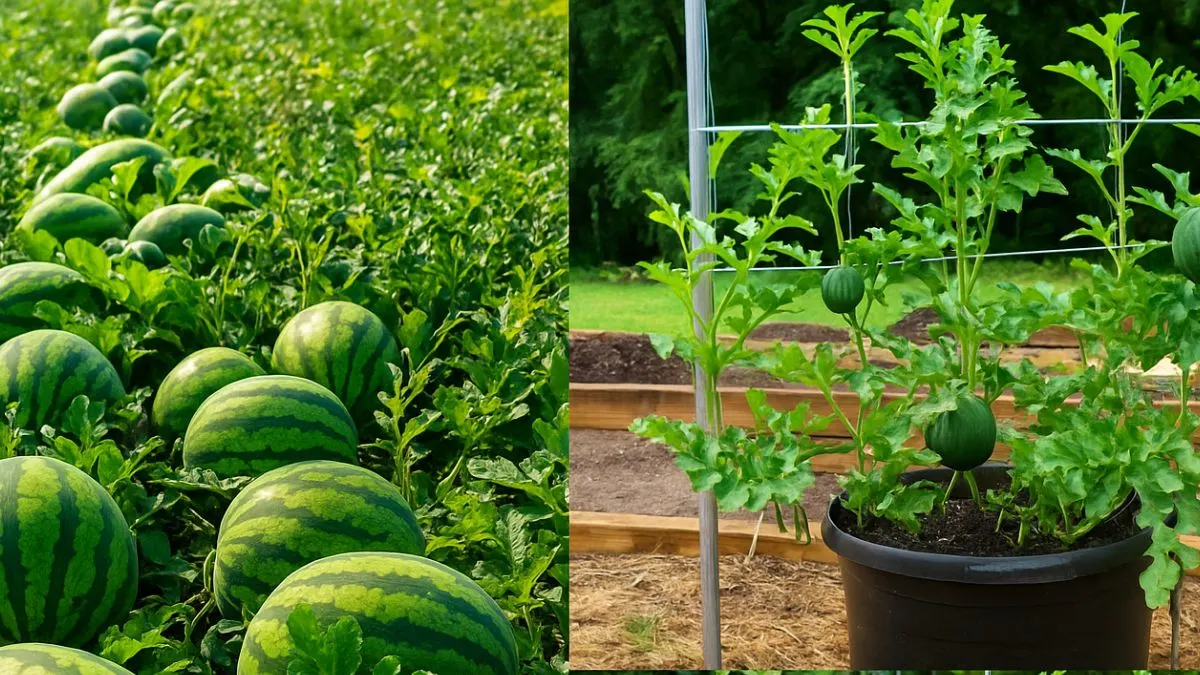There’s nothing quite like biting into a fresh, juicy watermelon on a hot summer’s day. But did you know you can grow this refreshing fruit right in your backyard or even in containers? Yes, it’s true. With warm soil, proper sunshine, and consistent care, you can enjoy homegrown watermelons that taste better than anything store-bought.
For gardeners in Canada, the USA, or anywhere else, growing your own watermelon is incredibly rewarding. Not only do you get sweet fruits, but you also learn patience and the joy of nurturing plants.
Choosing the Right Spot

Watermelons are sun worshippers. To thrive, they need:
- Somewhat sandy soils that drain well, lengthy periods of sunshine, and plenty of heat.
- At least 6–8 hours of direct sunlight daily.
- Open space for vines to spread out, since they can easily cover 6–10 feet of ground.
If your soil is heavy clay, don’t worry. Raised beds or mounds with compost mixed into the soil provide excellent drainage. The trick is to choose a hot, sunny spot in well drained soil.
Soil Preparation
Healthy soil means healthy melons. Watermelons thrive in slightly acidic to neutral soil (pH 6.0–7.0). For best results:
- Loosen the soil to 12–15 inches deep.
- Mix in compost or well-rotted manure.
- Ensure the bed has warm soil, since cold soil slows germination and growth.
I remember the first time I planted watermelons; I didn’t wait for the soil to warm up. The seeds struggled, and germination was patchy. The following year, I waited until late spring when the soil was warm, and the results were dramatically better.
Also Read: The Two-Pot Trick: How to Grow Potatoes in Small Spaces
Planting Watermelon Seeds
Watermelon seeds should be planted after the last frost when soil temperatures are consistently above 70°F (21°C).
- Sow seeds 1 inch deep.
- Space hills about 4–6 feet apart.
- Place 2–3 seeds per hill, thinning them later to the healthiest plant.
This ensures strong seedlings that can take advantage of Sun + bees + well-drained sandy soil + water for maximum fruiting.
Watering and Care
One of the most crucial steps in watermelon care is water management.
- Keep soil moist but not waterlogged. Overwatering can cause root rot, while underwatering leads to small, dry fruits.
- Deep watering once or twice a week is better than frequent shallow watering.
- Reduce watering when fruits start to mature—this concentrates sweetness.
If you’re growing in containers, be extra mindful. Container soil dries out faster, so you may need to water more frequently.
Pollination: Nature’s Magic
Watermelons rely on pollinators. Flowers are separate male and female blooms, and bees transfer pollen between them. Without pollination, fruits won’t develop.
If you don’t see many bees, hand-pollination works well. Use a small brush or cotton swab to transfer pollen from male to female flowers.
This step highlights why Sun + bees + well-drained sandy soil + water is the perfect formula for success.
Also Read: Celery Health Benefits: 14 Reasons to Eat It Every Day
Fertilizing Watermelons
Like most fruiting plants, watermelons are heavy feeders.
- Start with nitrogen-rich fertilizer for leaf and vine growth.
- Switch to phosphorus and potassium-heavy feed once flowers appear.
- Avoid over-fertilizing, as too much nitrogen encourages leaves, not fruits.
A balanced feeding routine, combined with somewhat sandy soils that drain well, ensures large, juicy melons.
Common Problems and Solutions
Problem |
Cause |
Solution |
Small fruits |
Poor pollination |
Encourage bees or hand-pollinate. |
Yellow leaves |
Overwatering or nutrient imbalance |
Adjust watering, add balanced fertilizer. |
Cracked fruits |
Inconsistent watering |
Maintain even moisture throughout the season. |
Poor germination |
Cold soil |
Always plant in warm soil after frost danger has passed. |
Harvesting Watermelons
Here’s the big question: how do you know when your watermelon is ready?
- The curly tendril nearest the fruit stem turns brown and dries.
- The underside touching the ground changes from white to creamy yellow.
- A deep hollow sound when tapped indicates ripeness.
Most varieties mature in 70–90 days from planting. Once you pick your first melon, you’ll realize why growing your own watermelon is incredibly rewarding.
Also Read: From Root to Remedy: How to Grow Turmeric Indoors Easily
Watermelons are a symbol of summer—sweet, juicy, and refreshing. Learning how to grow watermelons means you can enjoy them straight from your own garden, whether you’re in the USA, Canada, or beyond.
Just remember the essentials: somewhat sandy soils that drain well, lengthy periods of sunshine, and plenty of heat. Add warm soil, pollination (bees or hand-pollination), and regular deep watering, and you’re set for success.
So, grab your seeds, choose a hot, sunny spot in well drained soil, and start planting. With patience and care, you’ll soon harvest fruits that embody summer’s joy.
🍉 After all, few gardening experiences are as satisfying as slicing open a perfectly ripe melon you grew yourself!






